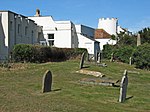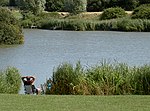Burnham-on-Sea railway station
Burnham-on-SeaDisused railway stations in SomersetFormer Somerset and Dorset Joint Railway stationsPages with no open date in Infobox stationRailway stations in Great Britain closed in 1963 ... and 3 more
Railway stations in Great Britain opened in 1858Use British English from March 2017Wikipedia page with obscure subdivision

Burnham-on-Sea railway station was located within the town of Burnham-on-Sea, Somerset, and was the terminus of the Burnham branch of the Somerset and Dorset Joint Railway. Opened as Burnham by the Somerset Central Railway on 3 May 1858, it was renamed in 1920.
Excerpt from the Wikipedia article Burnham-on-Sea railway station (License: CC BY-SA 3.0, Authors, Images).Burnham-on-Sea railway station
Old Station Approach,
Geographical coordinates (GPS) Address Nearby Places Show on map
Geographical coordinates (GPS)
| Latitude | Longitude |
|---|---|
| N 51.234049 ° | E -2.997219 ° |
Address
Old Station Approach
TA8 1DE , Burnham-on-Sea and Highbridge
England, United Kingdom
Open on Google Maps









